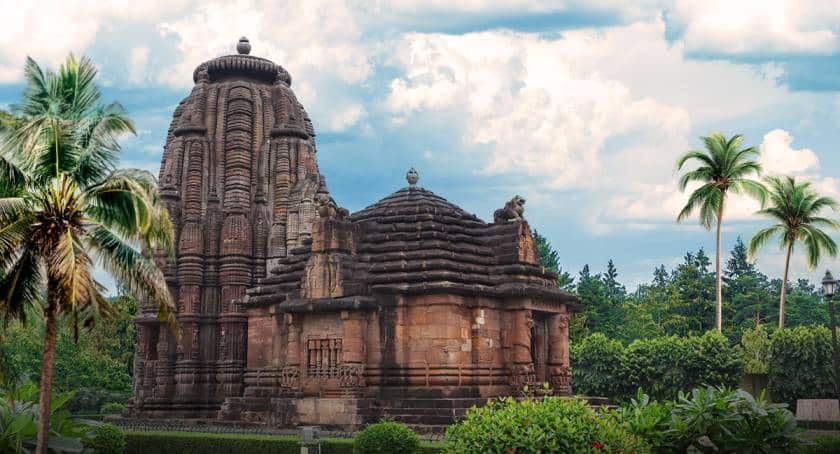Rajarani Temple, Bhubaneswar
Bhubaneswar, the central city of Odisha, is often called the “Temple City of India” due to its vast collection of ancient temples, each with unique architectural splendor and historical significance. Among these, the Rajarani Temple stands out as a beautiful example of the magnificence of Kalinga architecture. With its complexly carved sculptures, mesmerizing tower, and rich historical background, Rajarani Temple is a must-visit for history and architecture enthusiasts.
A Look into the Past
The people believe that builders constructed the Rajarani Temple, an important architectural wonder of Odisha, between the 11th century AD. Scholars suggest that the Somavamsi dynasty erected it, although no inscriptions confirm its exact construction period. Unlike many other temples in Bhubaneswar, this temple does not have an idol or deity, which has led to speculation regarding its original purpose.
The temple prominently features Lord Shiva because of the Shaivite sculptures around its structure, including depictions of Lord Shiva and Goddess Parvati. However, some historians argue that it may have served as a temple dedicated to Vishnu or other deities in the Hindu pantheon. Despite the absence of an active deity, the temple remains a significant historical and cultural landmark in Odisha.
Why is it Called Rajarani Temple?
One of the most intriguing aspects of the temple is its name. Unlike other temples named after deities, Rajarani Temple derives its name from the unique reddish-golden sandstone used in its construction, known locally as ‘Rajarani’ stone. This stone gives the temple an ethereal glow, particularly during sunrise and sunset, making it a sight to behold. The warm hues of the sandstone add to the temple’s beauty, making it a fascinating attraction for visitors and photographers alike.
Architectural Majesty of Rajarani Temple
Rajarani Temple showcases the finest example of Kalinga architecture, with its towering spires, detailed carvings, and elaborate sculptures. The temple follows the Pancha Ratha style, a characteristic feature of temples in Odisha, and consists of two main structures:
Vimana (Sanctum Sanctorum): The main sanctum, or garbhagriha, rises curvilinearly and is adorned with ornate carvings of celestial beings, deities, and mythical creatures. The vimana is the tallest structure in the temple complex and follows the classical rekha deul style, typical of Odishan temple architecture. The artisans beautifully sculpted the spire, depicting complex floral patterns and divine motifs, which makes it a stunning visual treat for visitors.
Jagamohana (Assembly Hall): This structure is slightly lower in height and serves as the congregation area for devotees. The jagamohana follows the pidha deul architectural style, which consists of horizontal layers stacked in a pyramidal shape. The assembly hall features detailed carvings on its walls, showcasing religious themes, dancers, and celestial beings. Although the temple no longer serves as a place of worship, its architectural design offers insight into the temple-building traditions of ancient Odisha.
Magnificent Carvings and Sculptures
One of the most remarkable features of the Rajarani Temple is its beautiful sculptures, which portray scenes from Hindu mythology, celestial dancers (apsaras), and couples in various postures of love and devotion. These carvings resemble the artistic traditions of the Khajuraho temples in Madhya Pradesh, leading many to refer to the Rajarani Temple as the “Khajuraho of the East.”
Apart from celestial figures, the temple walls also feature detailed depictions of dikpalas (guardians of directions), such as Agni (fire), Indra (rain and thunder), Varuna (water), and Yama (death). Each figure is beautifully crafted with unique attributes, adding to the temple’s artistic grandeur. The delicate artistry of these sculptures showcases the expertise of ancient Odishan artisans, whose attention to detail inspires modern architects and historians.
The Religious and Cultural Significance
Though Rajarani Temple is no longer an active place of worship, it remains a vital symbol of Odisha’s cultural and religious heritage. The temple provides insight into the architectural prowess of ancient builders and inspires modern architects and historians.
Unlike many temples in Odisha dedicated to deities and actively used for worship, Rajarani Temple is unique in its purpose and function. Its lack of an idol raises many questions about its original use, with some historians suggesting that it might have been a royal retreat or a ceremonial structure rather than a traditional place of worship.
The Archaeological Survey of India (ASI) maintains and preserves the temple. Visitors can explore the temple complex, admire its artwork, and appreciate the past’s artistic legacy.
Final Thoughts
Rajarani Temple is an architectural wonder and evidence of Odisha’s rich history, artistry, and cultural heritage. Whether you are a history buff, an architecture enthusiast, or a spiritual traveler, visiting this temple will leave you mesmerized. With its complex sculptures, elegant design, and serene ambiance, Rajarani Temple remains one of the most captivating landmarks in Bhubaneswar.
If you’re planning a trip to Odisha, include Rajarani Temple in your itinerary and witness the magnificence of this timeless marvel. The temple’s blend of history, art, and mystery makes it a must-visit destination that intrigues and inspires visitors from all walks of life.


